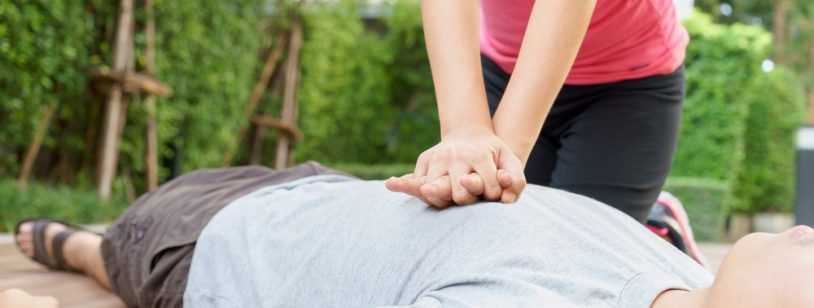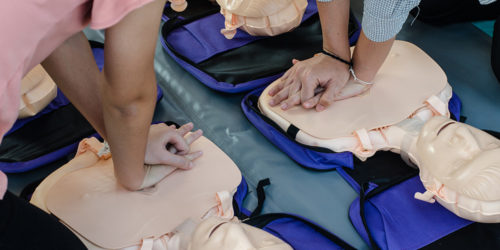Understand the Good Samaritan Law
Based on the parable of the same name, the Good Samaritan law establishes that any person who attempts to help a stranger should not be faced with legal action in response to their actions. This law offers protection to civilians when they offer assistance to ill, incapacitated, or otherwise imperiled individuals.
If a person is injured or in danger, good Samaritans can safely offer their protection and assistance without being fined, sued, or arrested for their actions. As long as the rescuer believes they are helping the victim, and the victim does not object to the help, the rescuer is protected by the Good Samaritan law.
In need of CPR or First-Aid certification?
Negligence and Duty-to-Assist
This law can also refer to ‘Negligence’ laws, laws which require able-bodied and able-minded individuals to lend reasonable help in the event of an emergency. As long as the person in question can offer assistance without putting themselves at risk, they are legally required to help in any way possible. However, if they do not succeed in saving the victim, the Good Samaritan Law can protect them against legal action. These laws work in tandem to encourage able individuals to lend help, while still protecting rescuers from a legal backlash.
For example, a person who offers CPR to a stranger will not face legal repercussions if they accidentally cause harm to the victim while offering aid. However, if they consciously chose to ignore the victim, they can face a lawsuit for negligence. This law protects rescuers and encourages people to step forward in the event of an emergency.
Although there are many situations in which the Good Samaritan law can be used, it offers basic protection to those who attempt to help others in good faith.
Who can invoke the Good Samaritan Law?
While these laws do not extend to on-duty doctors, paramedics, or other rescue officials, the law does offer protection to:
- Civilians stepping up during an emergency. (e.g. a stranger performing CPR on an incapacitated stranger.)
- Off-duty doctors/medical professionals lending help during an emergency. (e.g. a doctor pulling over to help at the scene of a car accident.)
- Military/federal personnel assisting during an emergency. (e.g. a soldier or rescue planning agent offering medical assistance.)
- Helicopter crews lending help during an emergency. (e.g. During a safety/traffic crisis, the helicopter crew will not be held liable for property damage caused while offering assistance.)
Variations of this law are present in all 50 states in the USA, and can also be found in many foreign countries. In certain situations, this law can also include organizations or businesses offering help during a crisis.
Voidance of Good Samaritan Law
This law does not excuse unprofessional/reckless conduct performed by on-duty emergency personnel or medical professionals. Because they have a fiduciary relationship with their patients, they are bound by different laws and codes of conduct. This law also excludes individuals who are acting with ulterior motives, such as a desire for money, fame, or other rewards. The Good Samaritan law was created to protect individuals who acted in good faith, not those with selfish intentions.
Consent by the victim must be given to render help. If the victim visibly and/or vocally objects to help and the rescuer continues to give it, they can be faced with legal repercussions. For example, if an individual insists that they do not require assistance, a civilian should not try and administer care to them without their permission. Exceptions to this can include:
- The stranger is unconscious, intoxicated, delirious, or otherwise mentally unfit to make decisions regarding their own safety. In court, this is judged according to the actions of a ‘reasonable, average person’. In other words, if the person was conscious and reasonable, would they consent to the given aid? In most cases, courts tend to be lenient in this regard, as most good-faith rescuers act with the victim’s best interests in mind.
- Parental consent is given. In cases involving unconscious/mentally unfit minors, consent must be given by the parent to administer treatment. Unless the guardian is absent, unconscious, or otherwise mentally unfit, the parent must be contacted before civilian help is given. However, if the parent refuses to allow life-saving help, they can be charged with neglect and the Good Samaritan Law still applies.
In certain states/jurisdictions, the Good Samaritan law only protects individuals with certified first aid training. Within these jurisdictions, an untrained/uncertified rescuer can be held liable for errors made during their treatment. The common belief is that they should not have stepped forward without being properly trained. It is important to know the specifics of your jurisdiction’s Good Samaritan law, so be sure to do state/specific research as soon as possible.
Examples of Good Samaritan Law in Action
An example of Good Samaritan law includes a situation involving a mother, child, and a well-meaning bystander. If the bystander witnesses an accident and believes the mother and child are in grave danger (the car is sinking underwater, the car is on fire, etc.), they should pull the victims from the car. In this situation, the child sustained a spinal cord injury and should not have been moved. By pulling them from the vehicle, the bystander unknowingly exacerbated the injury.
However, they cannot be held accountable for the child’s worsened condition because:
- They acted in good faith, with no ulterior motives.
- They acted as a reasonable, average person would.
- The victims were in imminent peril (fire/vehicle explosion/drowning).
- The mother/child did not object to the assistance.
- They did not knowingly injure the child further.
In this case, the mother cannot sue the bystander for helping, and she cannot demand reparation for her child’s condition. The bystander acted with good intentions, and rendered help voluntarily. They did not intend to cause damage and were not told to stop, so they are therefor protected by the Good Samaritan law.
However, if the victims had not been in danger, the bystander could be charged with reckless behavior. If the car was not on fire, sinking, or at risk of a second collision, the bystander should have left them in the car and called for emergency help. Pulling the child from the car without good reason could be classified as negligent behavior, as the bystander did not consider the effects of their actions.
In other situations involving negligence, the bystander could be faced with legal action for choosing to ignore the victim. If serious injury or death could have been avoided with a bystander’s help, the bystander can be charged for choosing to do nothing. An example of this goes as follows: A person in your vicinity falls unconscious or suffers a heart attack/seizure/stroke, and instead of calling emergency services or attempting to help, you choose to ignore the issue and do nothing. In this case, you can be charged with negligence by failing to lend help.
Duty-to-assist laws usually require bystanders to administer help, or at least dial 911. If the bystander is not trained in first aid, it is often recommended that they call 911 and calmly explain the situation before deciding on further action. They can then search for a trained person in the area, or stay with the victim until help arrives. Individuals with medical background and/or first aid training are required by duty-to-assist laws to remain with the victim and administer help until emergency services arrive.
Risk Assessment
In some cases, continuing to give aid can become unsafe for the rescuer, and they are no longer obligated to offer assistance. In these situations, they should get themselves to safety before calling for help. No rescuer is required to help someone if the process can put them in danger.
Situations like these can include:
- The bystander cannot render help without putting themselves at risk of infection (e.g. The victim is bleeding from the mouth, and CPR cannot be given safely).
- The environment is dangerous to the bystander, and they cannot offer assistance without putting themselves at risk (e.g. The bystander cannot swim, therefor they cannot give help to a drowning victim.).
- The bystander is not able to administer help (e.g. The bystander is not able-bodied or able-minded, and cannot offer assistance without putting themselves at risk.).
Other Countries with Good Samaritan Law
All regions of the United States have Good Samaritan laws, including the District of Columbia. These laws can differ between jurisdictions, but the core values of Good Samaritan law are the same. For example, the specifics of Good Samaritan law may vary between Massachusetts and Texas, so you should research your state at your earliest convenience.
Other countries with Good Samaritan laws include:
United Kingdom
While the ‘duty to assist’ law and ‘Good Samaritan’ laws in the UK are more lenient, there are still exceptions. You can be penalized for failing to take action if you are responsible for the accident, and you can also be persecuted for being grossly negligent/reckless during an emergency.
Finland
In Finland, it is expected that you act reasonably and without risk to yourself, but you should help those in danger. If you fail to act accordingly, you can be fined or sentenced to imprisonment for up to six months.
China
After the persecution of good Samaritans in 2006, the death of a toddler caused by neglect spurred the implementation of Good Samaritan law in China. The bystanders were afraid to help the child lest they be fined or persecuted themselves, so a law was established that would both punish idle onlookers and protect fault-less rescuers. The law went into effect in 2013.
Australia
Depending on the region, the Good Samaritan law can vary. In general, the law protects any individual that acted out of good faith, and did not cause the incident themselves.
Germany
According to German law, people who do not lend help during an emergency can be punished. However, Germany’s laws protect all good Samaritans, regardless of their training or effect on the victim. (I.e. Even if their help fails/worsens the victim’s condition, they will not be held liable.)
Canada
Good Samaritan law varies greatly between province. Typically, a good Samaritan will be protected from legal repercussions as long as they were not grossly negligent in their assistance. Quebec is the only province that has ‘duty-to-assist’ laws in place.
Ireland
While they do not have ‘duty-to-assist’ laws in place, Ireland’s Good Samaritan law protects any and all people that attempt to offer help, care, or advice to an injured/in-danger individual. This does not include those who act with ulterior motives, or are grossly negligent in their care.
This list is not exhaustive, but it does show that Good Samaritan Law is present in most countries with civil law. While these laws can vary between state, province, or country, most places offer protection to those who help others in good faith.
There is no ‘good time’ to research these laws, as there is no telling when you might require this information. It is better to be informed and prepared than caught off guard in the event of an emergency. For more information, try looking up your jurisdiction’s Good Samaritan laws online, or seek out legal assistance.




